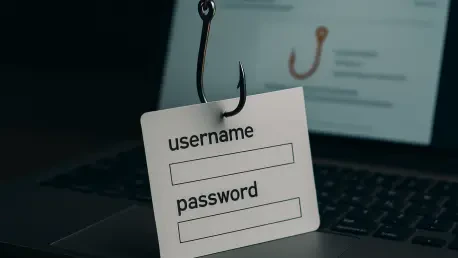In an era where cyber threats loom larger than ever, phishing attacks stand out as a relentless challenge for businesses across all sectors, striking at the heart of organizational security with alarming frequency. These deceptive schemes, often disguised as urgent emails or enticing offers, exploit human vulnerabilities to steal sensitive data, deploy ransomware, or cause financial havoc. Despite significant investments in phishing awareness training programs, many companies remain just as exposed to these threats as they were before implementing such initiatives. The disconnect between the intent of these training efforts and their real-world impact raises urgent questions about their effectiveness. This article delves into the persistent menace of phishing, unpacks the reasons behind the shortcomings of current training approaches, and explores alternative strategies that could better safeguard businesses. As phishing continues to evolve with sophisticated tactics, understanding these failures is not just important—it’s essential for building resilient defenses against an ever-growing cyber risk.
The Unrelenting Danger of Phishing Attacks
Phishing attacks have cemented their place as a formidable threat to businesses, regardless of size or industry, by preying on human emotions such as fear, curiosity, or a sense of urgency to manipulate employees into compromising security. These scams often arrive as seemingly legitimate emails, tricking recipients into clicking malicious links or divulging confidential information that can lead to catastrophic outcomes. According to a recent SpyCloud Identity Threat Report, a staggering 35% of businesses identified phishing as their primary attack vector, underscoring its dominance among cyber risks. The consequences extend far beyond mere inconvenience, often resulting in stolen data, significant financial losses, and irreparable damage to a company’s reputation. As attackers refine their methods, the challenge of staying ahead of phishing schemes becomes increasingly daunting, highlighting the urgent need for effective countermeasures that go beyond traditional approaches to truly protect organizational assets from this pervasive danger.
The impact of phishing as a gateway to more severe cybercrimes cannot be overstated, with many incidents serving as the initial breach point for devastating ransomware attacks that cripple operations. Businesses, both small and large, face heightened risks as these attacks grow in frequency and sophistication, often leveraging stolen credentials to infiltrate systems undetected. The financial and operational toll of such breaches can be staggering, with recovery efforts demanding substantial resources and time, not to mention the potential loss of customer trust. Beyond immediate damages, the long-term effects include regulatory penalties and diminished market confidence, which can haunt a company for years. This evolving threat landscape, where phishing acts as a linchpin for broader cyberattacks, emphasizes the critical importance of addressing this issue with strategies that are both proactive and adaptive to the cunning nature of modern cyber adversaries.
Unpacking the Flaws in Phishing Awareness Training
Despite the widespread adoption of phishing awareness training programs, mounting evidence suggests that these efforts often fail to deliver the protective outcomes businesses expect, leaving vulnerabilities unaddressed. A detailed study conducted by UC San Diego Health and Censys, which analyzed the behavior of over 19,500 employees across multiple phishing email campaigns, revealed a stark reality: there is no significant correlation between completing mandatory cybersecurity training and a lower likelihood of succumbing to phishing attempts. Even initiatives like simulated phishing exercises, intended to test and improve employee readiness, showed negligible results, with only a marginal 2% difference in failure rates between those who received training and those who did not. This disappointing performance points to a fundamental disconnect in how these programs are designed and received, suggesting that merely providing training is not enough to alter employee behavior in meaningful ways.
A deeper look into the reasons behind this ineffectiveness uncovers a critical issue: the lack of engagement with the training content itself, which severely undermines its potential impact on employee preparedness. Many employees spend less than a minute—or no time at all—interacting with the materials provided, rendering the sessions little more than a formality. This disengagement often stems from the format and delivery of the training, which may feel repetitive, irrelevant, or disconnected from real-world scenarios employees encounter daily. Without active participation or a sense of personal relevance, the lessons fail to stick, leaving staff just as susceptible to phishing attempts as they were prior to the training. Addressing this gap requires a reevaluation of how educational content is structured and presented, ensuring it resonates with employees and equips them with practical, actionable skills to recognize and resist deceptive tactics effectively.
Key Drivers Behind Training Failures
Several underlying factors contribute to the persistent failure of phishing training programs, revealing why they struggle to curb the success of cyber scams targeting employees. One significant driver is the content and design of phishing emails themselves, which are often crafted to exploit specific triggers—emails about vacation policy updates, for instance, saw click rates exceeding 30%, while mundane password update requests barely registered. This demonstrates how attackers tailor their messages to maximize emotional or situational appeal, easily bypassing the general warnings provided in standard training. Moreover, the format of training often fails to simulate these nuanced, persuasive tactics, leaving employees unprepared for the real-world cunning of phishing attempts. Recognizing and countering these targeted strategies is crucial, yet current programs frequently fall short in providing the depth needed to build such resilience.
Another alarming trend exacerbating training ineffectiveness is the erosion of employee vigilance over time, as prolonged exposure to phishing campaigns increases susceptibility to mistakes. Research indicates that click rates on phishing emails can surge from an initial 10% in the first month to over 50% by the eighth month of a sustained campaign, illustrating a dangerous decline in caution. This suggests that one-time or infrequent training sessions are insufficient to maintain awareness, as employees grow desensitized or fatigued by repeated alerts without reinforcement. The inability of current programs to sustain long-term behavioral change points to a need for ongoing, dynamic education that adapts to evolving threats and keeps staff alert. Without addressing this temporal vulnerability, businesses remain at heightened risk, as attackers exploit the predictable patterns of human forgetfulness and complacency over extended periods.
Charting a Path Beyond Traditional Training
Given the limitations of relying solely on awareness training to combat phishing, a growing consensus among experts advocates for a more comprehensive approach that integrates robust technical defenses with innovative educational methods. Solutions such as two-factor or multi-factor authentication (2FA/MFA) offer a critical layer of protection by ensuring that even if credentials are compromised, unauthorized access is thwarted. Similarly, restricting credential usage to trusted domains can prevent attackers from exploiting stolen information on fraudulent sites. These technical measures act as vital safeguards, reducing the reliance on human judgment alone to prevent breaches. As phishing attacks become more sophisticated with tools like artificial intelligence and infostealers, embedding such defenses into organizational systems is no longer optional but a necessary step to mitigate risks effectively.
In parallel, transforming the delivery of phishing training holds promise for overcoming the engagement barriers that plague current programs, fostering a deeper understanding among employees. Interactive methods like gamification, tabletop discussions, and in-person seminars can make learning more compelling and relevant, encouraging active participation rather than passive consumption of content. By simulating real-world scenarios in a hands-on manner, these approaches help employees internalize the skills needed to identify and resist phishing attempts, creating a lasting impact on behavior. Additionally, regular refreshers and tailored content that reflect the latest phishing tactics can sustain vigilance over time. Combining these educational innovations with technical barriers offers businesses a more holistic strategy to address the human factor in cybersecurity, paving the way for stronger, more resilient defenses against an ever-evolving threat landscape.









